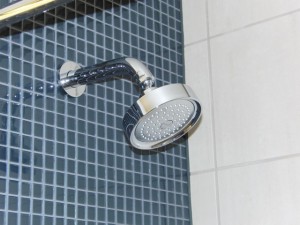
Taking a shower should be enjoyable, meant to energize you in the morning, calm you in the evening
and always leave you feeling refreshed and clean. Unfortunately, little annoyances can detract from the
overall experience, so we have created a list of the top five shower problems and solutions to resolve them.
1. Running Out of Hot Water
If you have a tank-type water heater, there is a finite amount of hot water you can use before you deplete the reserve in the storage tank, which usually holds from 30 to 50 gallons. This becomes unpleasantly apparent whenever you start a shower after someone has just taken one for an hour—there is little to no hot water left.
A Noritz tankless water heater eliminates this problem. Unlike traditional water heaters, which constantly heat the water, tankless operates on-demand with a high-powered burner. This means that once you turn that faucet, the tankless unit will kick into gear, and you will enjoy as much hot water as you need for as long as you need it. You could even take a five-hour shower. Just don’t blame us for the water bill.
2. Waiting for Hot Water
When you step into your shower, you want to get clean now…not three minutes later when the water has finally warmed to a suitable temperature. Waiting around for warm water is not only an annoyance, but also an energy-waster, since potentially gallons of unused cold water — and hot water if you wait too long to get in — are flowing down the drain.
You may reduce the wait time for hot water by installing a tankless water heater, which will heat water on demand. However, this does not eliminate the time it takes for the water to travel from the heater to the shower head. A better solution involves installing a hot water recirculation system that will keep warm water close to the outlet with the help of a timer or sensor. The new Noritz NRCP Condensing Tankless Water Heater uses a built-in pump to circulate hot water on demand, eliminating both the wait for and the waste of hot water.
3. A Clogged Drain
Clogged drains can mean having to stand in stagnant water while showering. Yuck. Most of the time, hair and dirt cause these clogs, and they can be avoided by placing a hair catcher in your drain. Another preventive measure involves pouring a gallon of boiling water down the drain after showering to loosen up any remaining gunk.
For tougher clogs, you can use a bent wire to remove hair, dirt and soap scum. Vinegar or any CLR product can also be poured down the drain to unclog it. In some cases, a good old-fashioned plunger may be required to remove the obstruction. If none of these options work, it may be time to call a plumbing professional.
4. Reduced Flow
You are standing in the shower enjoying a refreshing blast of water when suddenly the torrent turns into a sprinkle and you can barely wash your hands, much less your body. What Most plumbing systems use a trunk-and-branch design, meaning that a large pipe (a “trunk”) runs from one end of the structure to the other, and smaller pipes “branch” off to individual fixtures. If you are taking a shower on the far end of your home and someone opens a faucet,starts a clothes washer or flushes a toilet, water will get diverted, and you will be left with less. Many fixes to this problem can be costly, such as increasing your pipes’ diameter so more water flows toward each fixture. One totally free option that you can implement today is to reduce your toilet’s water usage. Close the supply valve to your toilet slightly, so that it does not take in as much water. Check with a plumber before doing this, though, since the less water going to the toilet, the less flushing power it has!
5. Bursts of Hot Water
The opposite of running out of hot water in your shower is getting scalded by a sudden rush of This problem has the same cause as “Reduced Flow”: if you are in the shower and someone flushes a toilet elsewhere, cold water is getting drawn to the toilet. With less cold water “tempering” your hot water, the water coming into your shower will be much hotter than the Installing high-efficiency toilets should help alleviate this problem by reducing the amount of water needed to flush them. Another fix involves installing a thermostatic mixing valve in your showers. This device will modulate the hot- and cold-water flows, whatever the usage by other fixtures, to keep the temperature of the shower consistently safe as well as comfortable.
